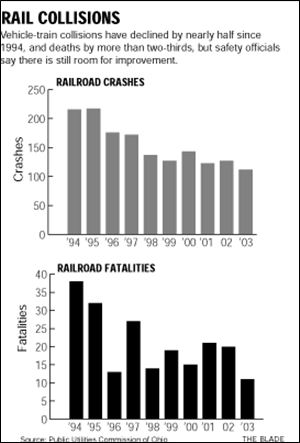
Railroad-crossing crashes, fatalities down
5/13/2004
Crashes and fatalities at Ohio railroad crossings reached historic lows during 2003, consistent with a national trend toward fewer train-vehicle collisions, state safety officials said yesterday.
The Public Utilities Commission of Ohio's annual crossing-safety report lists 112 vehicle-train collisions in the state last year, down from 127 in 2002 and fewer than half the 254 such crashes reported 10 years earlier. Last year's collisions included 10 involving fatalities, with a total of 11 deaths.
The records appear to have overlooked a fatal crash in Defiance County on Feb. 18, 2003; the PUCO report lists no crashes during the year in Defiance County. But even if that collision is added in, the crash and fatality totals are the lowest since such records started being kept.
Northwest Ohio continued to have a relatively high accident rate due to its extensive roadway grid and flat terrain that favors level crossings instead of costlier bridges where roads meet rails. Six of the 10 fatal crashes listed in the PUCO report, plus the seventh in Defiance County, occurred in Ohio's northwestern corner.
Many of the more serious collisions occurred in rural areas. While Lucas County's five crashes tied for the fourth-highest total during 2003, those crashes resulted in no deaths and just two injuries, whereas the year's only crossing crash in Paulding County, on Maple Street in Payne, Ohio, caused one death and three injuries.
Ohio's trend is consistent with nationwide statistics, the Ohio Rail Development Commission noted in a statement. Across the United States, crossing fatalities declined to 324 last year, 9 percent lower than in 2002 and 47 percent lower than 1994, according to the U.S. Department of Transportation.
James Seney, the rail commission's executive director, said the declining accident rate "validates" state officials' efforts to improve safety at the 6,300 rail crossings in Ohio, but added that work remains to be done.
"While these numbers tell us we're succeeding in reducing the carnage at railroad crossings, they also demonstrate we still have an obligation to work even harder on making Ohio's railroad crossings safer,"
Mr. Seney said. "We cannot allow this success to in any way minimize the loss of those who still perished in 2003, nor the sadness and mental pain felt by their survivors and train crews."
Because of their lighter traffic volumes, rural crossings are less likely to be equipped with warning lights and gates. The utilities commission's report said 61 percent of crossing crashes last year occurred at crossings lacking train-activated warning devices.
But that also means that 39 percent occurred at crossings that had at least flashing lights, if not gates as well. And half of the crossing deaths occurred at crossings with lights and gates, Stu Nicholson, a rail commission spokesman, said.
"We still have far too many people who will go around the gates," he said.
The Payne crash was one of two fatal crashes in 2003, along with another reported on March 14, 2004, occurring at crossings along a Norfolk Southern line that runs east-west across Paulding, Putnam, and northern Hancock counties.
In November, Mr. Seney announced plans to install warning lights and gates at all crossings on that line that do not already have them. During 2003, 48 Ohio crossings were equipped with new arrays of warning lights and gates.
Last month, the utilities commission announced a grant program offering up to $25,000 in state matching funds for roadway improvements at rural "hump crossings" where track elevation impairs motorists' view of oncoming trains. The funds are earmarked for crossings that do not already have lights and gates.
Full-year statistics for Michigan were not available yesterday, but a preliminary report with results through Dec. 2 showed a decline in crossing crashes in the Wolverine state. As of that date, 81 crashes had been reported in Michigan, down from 101 in 2002, and fatalities in those crashes dipped from eight to six.
Contact David Patch at:
dpatch@theblade.com
or 419-724-6094.